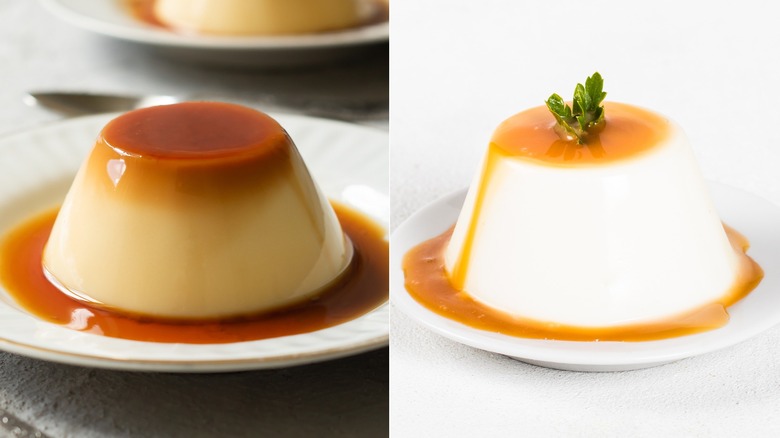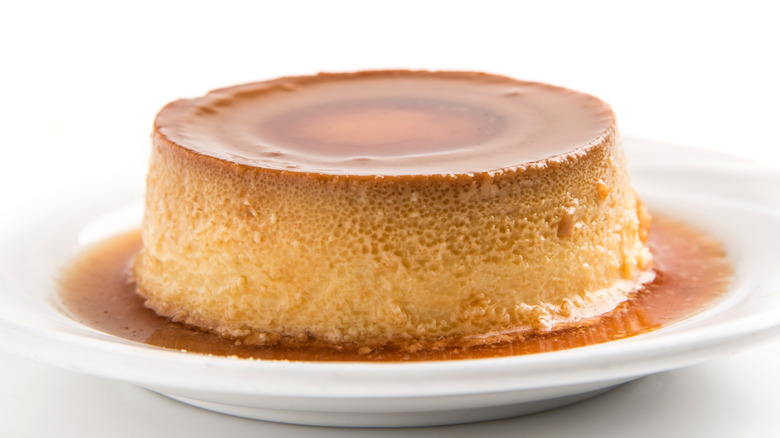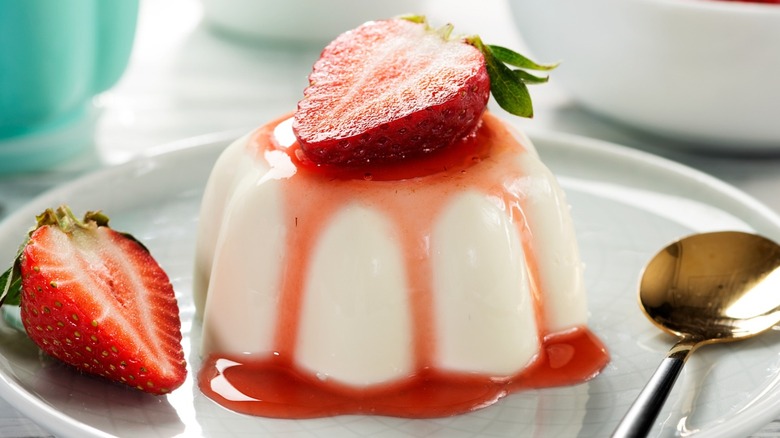Flan Vs Panna Cotta: What's The Difference Between These Desserts?
Custards are some of the most decadent and rich desserts, and two of the most popular are flan and panna cotta. At first glance, these dishes look very similar, but they are easy to tell apart when you know what to look for. The flan dessert has a caramel layer on top, for instance, while panna cotta commonly has a fruit coulis or caramel drizzle. However, there's more to the differences between flan and panna cotta than meets the eye.
First of all, flan has Roman and Spanish roots, while panna cotta has Italian roots. Another major difference is the ingredients: Flan gets its structure from using eggs, while panna cotta's structure comes from gelatin. Because of that, these custard desserts are also prepared differently. Flan is heated in individual baking cups in a stovetop water bath, cooled until set in the refrigerator, and, then, flipped out onto a plate to reveal the caramel bottom, which is now on top. On the other hand, panna cotta is mixed and heated in stages in a pan on the stove, poured into individual molds to set in the refrigerator, and served as is or flipped out onto a plate.
Additionally, flan and panna cotta differ in how they taste even though they have a very similar texture. The dominant flavor in flan is caramel, and it can have a nutty scent. Meanwhile, panna cotta can come in many flavors, including caramel and fruit, and smells more like a milky dessert.
The beloved Spanish dessert — flan
We have ancient Romans to thank for the foundation of flan. It was the result of having an abundance of eggs after they started domesticating chickens. At the time, flan was a savory dish with a meaty or fishy flavor. Eventually, it was sweetened with honey, a variation that spread in popularity throughout Europe as the Roman Empire expanded. During the Middle Ages, Spaniards started caramelizing the sugar used in the recipe, which is how we recognize it today. Flan then made its way around the world during the Age of Exploration and the Colonial Era, forever etching its place in culinary history.
While the traditional flan recipe — consisting of milk, eggs, sugar, and vanilla — has remained largely unchanged ever since, chefs around the globe like to play around with adding different flavors. For example, a coconut caramel flan recipe incorporates coconut milk to add a unique twist to flan. Fruit is a great addition as well, such as the orange in flan napolitano and the lime and berries in almond-infused Mexican flan with raspberry salsa. There are coffee and chocolate variations of this dessert, too.
The popular Italian dessert — panna cotta
Despite its similarities, panna cotta originated in Northern Italy's Piedmont region. Recipe books in Northern European countries — such as Denmark, Hungary, and France — refer to the dish or something similar as far back as the Middle Ages. The Danish moos hwit recipe, for instance, is the same and appeared in a cookbook written by Danish doctor and botanist Henrik Harpestræng, who died in 1244. It's believed that the work was translated from a German cookbook printed in the early 1200s.
In Italy, though, legend has it that a Hungarian woman living in the region first made the dessert in the early 1900s. Also, the first official mention of panna cotta — which translates to "cooked cream" — was on the menu of 1960s restaurant I tre citroni owned by Chef Ettore Songia, who is credited with making the recipe famous.
Beyond those murky origins, panna cotta is one of the top Italian desserts to know about. Modern recipes are still based on the traditional milk, cream, gelatin, sugar, and vanilla ingredients. Of course, chefs far and wide enjoy playing around with substitutions and flavors, such as panna cotta with sheep's milk or lemon and mascarpone. They've even been known to use rose petals, lavender, teas, and other herbs in the mixture. The topping is even more varied, featuring everything from caramel, chocolate, and spun sugar to fruit sauces, like in yogurt panna cotta with strawberry coulis.


